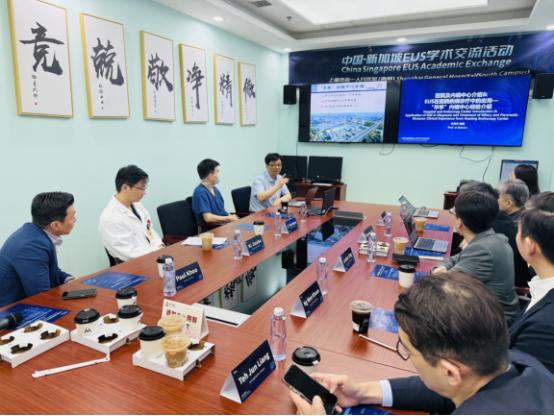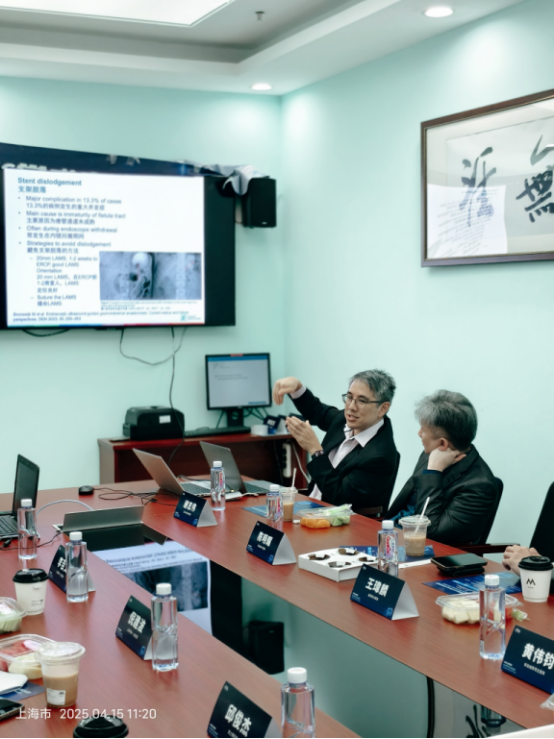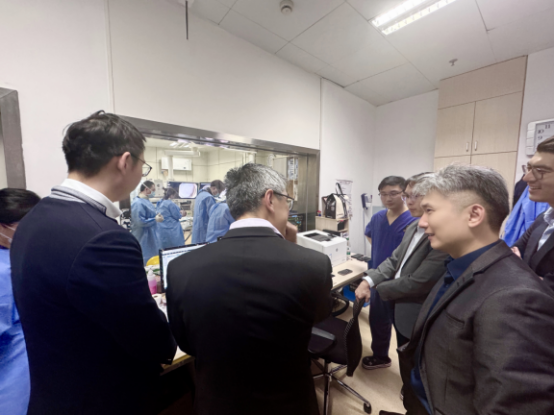- News
China-Singapore Academic Seminar on EUS Techniques was Successfully Held in Shanghai General Hospital
On April 15, 2025, a delegation of five distinguished experts from Singapore visited the Department of Digestive Endoscopy at Shanghai General Hospital (South Branch) for an academic exchange. The delegation is comprised of Prof. Chen Mingyao (Singapore General Hospital), Prof. Huang Weijun (Tan Tock Seng Hospital), Prof. Wang Weilin (Sengkang General Hospital) and Prof. Xie Zhiwei (Woodlands Health Campus). Given the international reputation of our hospital’s "Huating" Digestive Endoscopy Center in endoscopic ultrasound (EUS)-guided interventions, the event focused on in-depth discussions and practical sharing of EUS applications in pancreatobiliary diseases, as requested by the Singaporean delegation.
Elevating EUS Dialogue: Multidisciplinary Perspectives
Chaired by Prof. Ni Jianbo, Deputy Director of Digestive Endoscopy, the symposium began with a welcome opening speech by Prof. Li Baiwen, Director of the department. Prof. Li outlined the center’s milestones, innovations, and expertise in minimally invasive techniques like EUS and ERCP.


In his keynote lecture "Hua Ting Center’s Expertise: EUS in Pancreatobiliary Diseases", Prof. Li showcased the center’s pioneering techniques through, EUS-guided debridement/drainage of infected pancreatic collections, EUS-BD (biliary drainage) & EUS-PD (pancreatic duct drainage), EUS-mediated anastomotic stricture/occlusion recanalization, EUS diagnosis & treatment of pancreas divisum and disconnected pancreatic duct syndrome (DPDS), EUS-guided gastrojejunostomy (EUS-GE). Supported by case studies, clinical research, and device innovations, the presentation highlighted the center’s integrated approach to complex pancreatobiliary interventions.
Singaporean experts Prof. Xie Zhiwei and Prof. Chen Mingyao further shared their experiences with LAMS stents in complex procedures, sparking lively discussions on indications, protocols, and complication management.

Equal emphasis is placed on practical observation and in-depth interaction
In the afternoon, Professor Li Baiwen presented the highlight of the conference - live demonstrations of EUS-guided interventional procedures. Two highly challenging surgical operations were performed during the demonstration:
The first procedure was a EUS-HGS approach-assisted removal of residual large biliary stones and recanalization of anastomotic stricture/occlusion after gastrointestinal diversion using NOTES technique under EUS guidance. This case combined the concepts of EUS-guided hepaticogastrostomy and natural orifice transluminal endoscopic surgery, demonstrating cutting-edge techniques for minimally invasive biliary drainage, stone management, and recanalization of anastomotic occlusion in the context of post-operative anatomical variations.
The second procedure was EUS-guided transgastric drainage for severe acute pancreatitis complicated with walled-off necrosis (WON). This technique achieved effective drainage of infected pancreatic necrosis through real-time ultrasound localization and precise puncture, with standardized and safe operation procedures that served as an important demonstration. During the procedures, Professor Li's team demonstrated the complete workflow from imaging evaluation, approach selection, puncture operation to drainage tube placement, fully showcasing the team's mastery of complex interventional EUS techniques and multidisciplinary coordination capabilities. After the surgeries, participating experts engaged in enthusiastic discussions on case selection, technical approaches, and postoperative complication prevention, generating tremendous response.

A Shared Vision: Strengthening Regional Collaboration
In the closing remarks, Professor Li Baiwen, on behalf of the organizing committee, expressed gratitude to all Chinese and international experts for their active participation and enthusiastic sharing. This exchange has not only enhanced technical understanding and mutual trust in the field of EUS between China and Singapore, but has also provided a platform for establishing closer regional academic collaboration mechanisms in the future.
This China-Singapore EUS academic exchange event was not merely a high-level academic conference, but more importantly, a significant gathering that promoted international collaboration and shared clinical expertise. In the future, both parties will continue to deepen cooperation in talent cultivation, technical standardization, and cutting-edge research, working together to expand the clinical boundaries and developmental horizons of EUS in the diagnosis and treatment of pancreatobiliary diseases.

